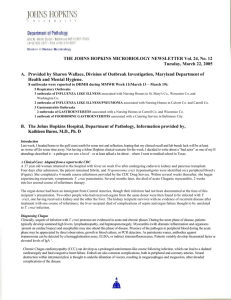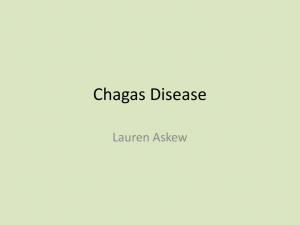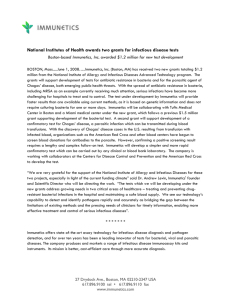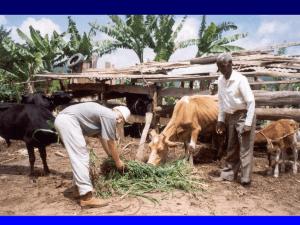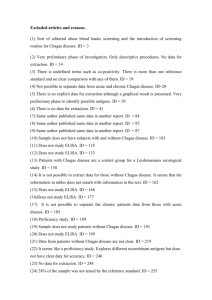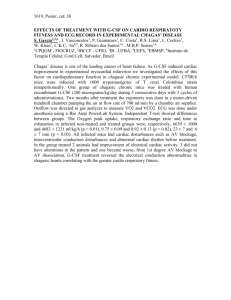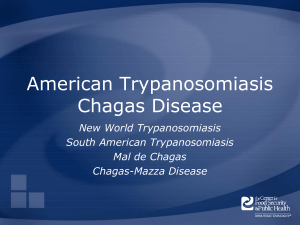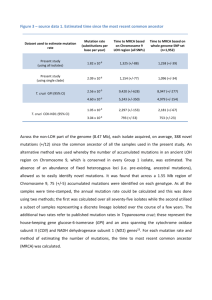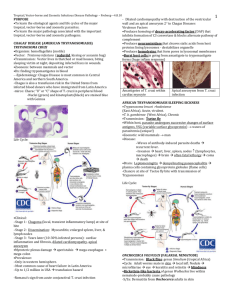- University of East Anglia
advertisement
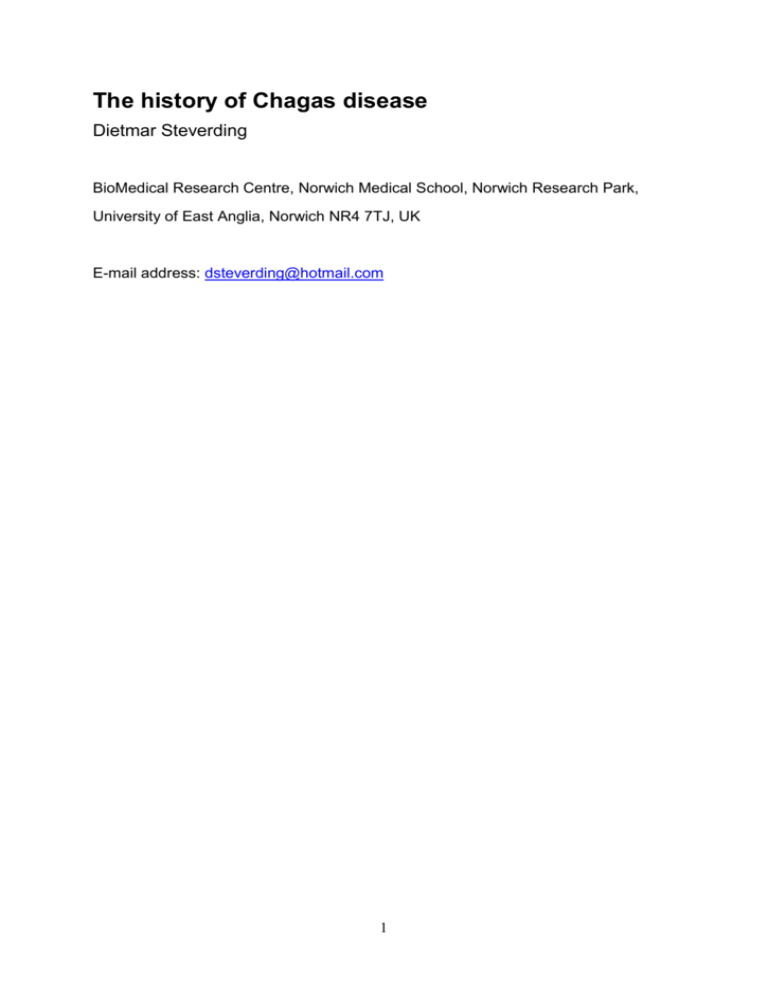
The history of Chagas disease Dietmar Steverding BioMedical Research Centre, Norwich Medical School, Norwich Research Park, University of East Anglia, Norwich NR4 7TJ, UK E-mail address: dsteverding@hotmail.com 1 Abstract The ancestor of Trypanosome cruzi was probably introduced to South American via bats approximately 7-10 million years ago. When the first humans arrived in the New World, a sylvatic cycle of Chagas disease was then already well established. Paleoparasitological data suggests that human American trypanosomiasis originated in the Andean area when people founded the first settlements in the coastal region of the Atacama Desert. Identification of T. cruzi as the etiological agent and triatome bugs as the transmission vector of Chagas disease occurred within a few years at the beginning of the 20th century. History also teaches us that human activity leading to environmental changes, in particular deforestation, is the main cause for the spread of Chagas disease. Recently, migration of T. cruzi-infected patients has led to a distribution of Chagas disease from Latin America to non-endemic countries in Europe, North America and western Pacific region. Keywords: Chagas disease, American trypanosomiasis, history, Trypanosoma cruzi 2 Background Chagas disease or American trypanosomiasis is a zoonotic infectious disease affecting humans in Latin America. The disease is caused by the protozoan flagellate Trypanosoma cruzi that lives and multiplies within cells from a variety of tissues. The parasite is usually transmitted via the faeces of blood-sucking bugs belonging to the subfamily Triatominae (kissing bugs or conenose bugs), with Triatoma infestans, Rhodnius proxilus and Panstrongylus megistus being the most important vectors. As T. cruzi cannot penetrate intact skin, it enters the human body through microlesions that have been introduced and contaminated with faeces when individuals scratch the itching vector’s bite. In addition, T. cruzi is able to break through intact mucous membranes (such as the conjunctiva and the gastric epithelium). Other modes of transmission include blood transfusion, organ transplantation, via breast milk, congenitally via the placenta and by ingestion of contaminated food and drink. Chagas disease is endemic in all South and Central American countries as well as in Mexico [1]. In addition, the southern half of the United States contains enzootic cycles of T. cruzi and autochthonous vector-borne human infections have been reported in Texas, California, Tennessee, Louisiana and Mississippi [2, 3]. There are two phases during the course of Chagas disease. The acute phase begins 6-10 days after infection and lasts for about 4-8 weeks [4]. In most cases, the acute phase passes unnoticed as the clinical symptoms are nonspecific (including fever, hepatosplenomegaly or lymphadenopathy) and are typical for many infections [5]. As a specific symptom, inflammatory oedema at the site of infection may be observed. If the entry site is the skin, the swelling is known as a chagoma. In case the entry point is the eye, a unilateral periorbital swelling, a so-called Romaña’s sign, may develop. Acute myocarditis and acute meningoencephalitis can be occasionally seen in young children aged 1-5 years and is in most cases fatal [4]. Abnormalities in the ECG are observed in about 50% of cases which usually disappear later in the disease course [6]. During the acute phase, circulating trypanosomes can be easily found in the blood of patients [5]. Eventually, the parasite and the host reach an immunological balance and the disease enters the chronic phase. In this phase, the parasitaemia is greatly reduced and the patients become asymptomatic. Most patients remain 3 in a so-called indeterminate (latent) chronic stage for the rest of their lives and do not develop any chronic symptoms. However, 15-30% of infected people will enter the determinate (symptomatic) chronic stage of the disease associated with the manifestation of organ damage [5]. This usually happens 10-25 years after the initial infection [5]. Typical manifestations are the dilatation of the heart (chronic chagasic cardiomyopthy) and/or parts of the digestive track (megaoesophagus and megacolon). Although the clinical manifestation of megaoesophagus and megacolon can be extremely debilitating conditions for many patients, the development of cardiomyopathy is a life-threatening problem in most cases. The different pathologies of Chagas disease are caused by six discrete typing units (DTUs) of T. cruzi (TcITcVI), which have distinct geographical distributions and extensive genetic diversity [7]. In contrast to African trypanosomes which were important selective factors in the human evolution [8], American trypanosomes affected human beings only recently who arrived in the New World less than 15,000 years ago [9]. Origin of T. cruzi Phylogenetic analysis of 18S rRNA sequences indicates that salivarian trypanosomes (the T. brucei clade grouping those trypanosomes that are transmitted by bites) diverged from the stercorarian trypanosomes (T. cruzi clade grouping those trypanosomes that are transmitted by faecal contamination) approximately 100 million years ago [10]. As at the same time South America, Antarctica and Australia separated from Africa, it was suggested that T. cruzi and related trypanosomes evolved in isolation in early terrestrial mammals [11]. This idea is known as the southern super-continent hypothesis. Based on this scenario one would expect a high diversity of T. cruzi clade trypanosomes in South American terrestrial mammals provided that they had been present on the continent since the break up the southern supercontinent 40 million years ago [11]. However, this is not the case. No bona fide species have been discovered in the T. cruzi clade from any South American terrestrial mammal to date [11], i.e., no co-evolution generating host species specific genotypes has occurred. In addition, as T. cruzi clade trypanosomes are also present in land mammals from Africa and Australia [11], the role of geographical isolation in the evolution of T. cruzi is questionable. 4 Recent molecular evidence indicates that T. cruzi has evolved from a bat trypanosome, a scenario known as the bat seeding hypothesis [11]. This idea is supported by the fact that the closest genetically characterised relative of T. cruzi is T. marinkellei from South American bats [10,12-14]. Both diverged approximately 6.5-8.5 million year ago [15, 16] and could be regarded as subspecies (i.e. T. c. cruzi and T. c. marinkellei) [17]. The recently described T. erneyi and T. livingstonei found in bats from Mozambique [18, 19], and T. dionisii from Old and New World bats [10, 12, 14, 20] are also close relatives of T. cruzi. Moreover, T. cruzi has been detected in South American bats [12, 21, 22] with one specific genotype, TcBat, only found in bats so far [23]. TcBat is most closely related to T. cruzi TcI which primarily is associated with opossums and conenose bugs of the genus Rhodnius in arboreal ecotopes [11]. Based on these facts it is reasonable to suppose that the common ancestor of the members of the T. cruzi clade was a bat trypanosome. Presumably, trypanosome-infected bats have colonised South America about 7-10 million years ago via North America [24]. Then, various independent bat trypanosome lineages switched from bats into terrestrial mammals probably facilitated by invertebrate vectors feeding on both bats and terrestrial mammals living in the same arboreal ecotopes [10]. One such switch gave rise to T. cruzi in the Pliocene [25]. The diversification of T. cruzi into the current DTU lineages TcI-TcVI and TcBat started quite recent about 1-3 million years ago [25]. Pre-Columbian Time There is evidence that soon after having populated South America humans became infected with T. cruzi. The earliest detection of a T. cruzi infection in a human comes from a 9000 year old Chinchorro mummy through PCR amplification of kinetoplasid DNA sequences [26]. The Chinchorros were the first people identified to settle along South American’s coastal region of the Atacama Desert in southern Peru and northern Chile. T. cruzi infections were also found in mummies of subsequent cultures that succeeded the Chinchorros and were living in the same area up to the time of the Spanish conquest in the 16th century [26]. The prevalence rate for T. cruzi infection in these populations was 41% without any significant differences among the individual cultures indicating that already in pre-Columbian time 5 Chagas disease was widely spread in civilised societies [26]. Infections with T. cruzi were also detected in human remains from other archaeological excavation sites in America [27]. For example, T. cruzi DNA was found in a 560 year old partially mummified human body and in a 4,500-7,000 year old human bone fragment both unearthed in the Peruaçu Valley in the State of Minas Gerais, Brazil [28, 29]. Another case of a prehistoric T. cruzi infection was reported in a 1,150 year old mummy recovered from the Chihuahuan Desert near the Rio Grande in Texas [27]. In addition to the detection of T. cruzi in human remains, several exhumed mummies also showed clinical signs of Chagas disease [26-28, 30]. Further evidence of American trypanosomiasis in Pre-Columbian times comes from Peruvian ceramics dated to the 13th-16th centuries showing possible representations of Chagas disease [31]. This also included a head with a unilateral swelling of the eyelid reminiscent of the Romaña’s sign [31]. Based on the paleoparasitological data, it has been hypothesised that Chagas disease originated in the Andean region [32]. It is believed that the Chinchorro people were the first to leave a nomadic lifestyle and to settle down to start arable farming and livestock breeding [26, 30, 31]. Upon settlement, prehistoric people intruded and participate in the sylvatic cycle of T. cruzi, and gradually a domestic cycle of transmission of Chagas disease emerged [26, 31, 32]. The development of a domestic T. cruzi transmission cycle was facilitated by the ability of some species of triatomine bugs, in particular T. infestans, to adapt easily to more open vegetation and to develop a preference for human dwellings over time [33]. In this context, it is important to note that the establishment of agricultural settlements usually involves some degree of deforestation. Crucially, deforestation is strongly linked to an increase in the prevalence of Chagas disease [33]. This connection is supported by the fact that American trypanosomiasis is absent in the indigenous inhabitants of the Amazon region, who used different socio-environmental patterns of land occupation including open communal huts unfavourable for vector colonisation, continuous mobility, and absence of domestic animals which all together hinder vector transmission of Chagas disease [34]. 6 Modern Times 16th-19th Century From the 16th century onwards, there are several accounts by travellers and physicians describing patients with disease symptoms reminiscent of American trypanosomiasis. A first suggestive clinical report relating to possible intestinal symptoms of Chagas disease comes from a book published in 1707 by the Portuguese physician Miguel Diaz Pimenta (16611715) [35]. Therein he described a condition, which was known as “bicho”, “that causes the humours to be retained, causing the patient to have little desire to eat”. However, a more detailed analysis of the text suggests that the symptoms described refer more likely to haemorrhoids rather than to the clinical picture of a chagasic megacolon [36]. A clearer account on the megavisceral syndrome of Chagas disease comes from another Portuguese physician, Luís Gomes Ferreira (1686-1764), who wrote in 1735 that “the corruption of bicho is nothing else but an enlargement and distension of the rectum” [37, 38]. Other records described a condition known then as “mal de engasgo” which probably refers to dysphagia, the difficulty in swallowing [39-41]. For example, the Danish physician Theodoro J. H. Langgaard (1813-1884), who emigrated to Brazil in 1842, gave the following characteristic description of the condition: “…usually the food bolus only passes up to the cardia above the stomach. … Some patients are able to force the descent of the food into the stomach by drinking a small amount of water after each mouthful of ingested food. … As a result of the imperfect nutrition the patients begin to lose weight, become emaciated…” [37, 41]. Many more storied references to Chagas disease can be found in an article by Guerra [42]. All these historical accounts indicate that Chagas disease was present in Latin America from the beginning of the 16th century and that it was affecting indigenous people as well as the conquistadors. There are also many reports of triatomine bugs long before their role as vector for T. cruzi was discovered (reviewed in [31] and [37]). Probably the most famous account of a kissing bug comes from Charles Darwin (1809-1882). On the 25th of March 1835 he noted in his diary which he kept during his voyage of The Beagle: “At night I experienced an attack (for it deserves no less a name) of the Benchuca (a species of Reduvius) the great black bug of the 7 Pampas. It is most disgusting to feel soft wingless insects, about an inch long, crawling over one’s body. Before sucking they are quite thin, but afterwards become round and bloated with blood, and in this state they are easily crushed. They are also found in the northern part of Chile and in Peru. One which I caught at Iquique was very empty. When placed on the table, and though surrounded by people, if a finger was presented, the bold insect would immediately draw its sucker, make a charge, and if allowed, draw blood. No pain was caused by the wound. It was curious to watch its body during the act of sucking, as it changed in less than ten minutes, from being as flat as a wafer to a globular form. This one feast, for which the benchuca was indebted to one of the officers, kept it fat during four whole months; but, after the first fortnight, the insect was quite ready to have another suck” [43]. Based on this encounter with a kissing bug and his prolonged gastric and nervous symptoms, it was even hypothesised that Darwin was suffering from Chagas disease later in his life. However, Chagas disease is a most unlikely diagnosis for Darwin’s chronic illness as the symptoms abated as he aged, as he did not seem to have any of the typical chagasic symptoms and as he had some of the symptoms already before the Beagle voyage [37]. Despite all these reports, the critical role of triatomine bugs in transmitting Chagas disease remained undiscovered until 1909. 20th Century In 1908, during an anti-malaria campaign in support of the construction of a railway track in the North of the state of Minas Gerais, the Brazilian hygienist and bacteriologist Carlos Chagas (1879-1934) (Figure 1) was made aware by a railroad engineer of large bloodsucking insects which lived en masse in local dwellings and bit sleeping people preferentially in the face [44]. To see whether these bugs harboured potential pathogens, Chagas dissected them and found numerous trypanosomes in their hindgut which he named T. cruzi in honour of his mentor, the Brazilian physician and bacteriologist Oswaldo Cruz (1872-1917) (Figure 2) [45]. Some infected bugs were sent to Cruz in Rio de Janeiro, where they were allowed to bite marmoset monkeys. Within 20-30 days, the monkeys became infected and many trypanosomes were detected in their blood [44]. Soon afterwards Chagas also discovered that 8 the parasite was infective to several other laboratory animals [44]. Chagas was sure that he had found a pathogenic organism of a human infectious disease but did not know what kind of sickness it was. The breakthrough came in 1909 when he was called to examine a two year old girl named Berenice who was feverish with enlarged spleen and liver and swollen lymph nodes [44]. On first examination, no parasites were found but four days later, on the 14th of April 1909, numerous trypanosomes were spotted in her blood with similar morphology to those previously detected in infected marmoset monkeys [44]. Chagas had discovered a new human disease which soon bore his name. He gave a detailed clinical description of the acute phase of the disease and linked the infection with some chronic symptoms of the illness which was remarkable considering that the chronic phase of American trypanosomiasis usually appears decades after the first inoculation with T. cruzi (reviewed in [46]). Interestingly, his first patient Berenice never developed determinate chronic Chagas disease and died at the age 73 years on unrelated causes [47]. However, she was infected with T. cruzi for her whole life as was confirmed by the isolation of parasites when she was 55 and 71 years old [47]. In 1912, Chagas reported that he had detected T. cruzi in an armadillo and thus found the first sylvatic reservoir host [48]. Gradually, more and more sylvatic reservoir animals of Chagas disease were discovered providing evidence for an enzootic cycle of T. cruzi. Without doubt, the discovery of American trypanosomiasis is inseparably linked to Carlos Chagas. However, other researchers have also contributed to the findings. Oswaldo Cruz’s mentoring and the institute he and the Brazilian government founded in 1900 to fight endemic diseases played an important role in the uncovering of Chagas disease [49]. The identification and characterisation of T. cruzi was the result of collaboration with the Czech zoologist and parasitologist Stanislaus von Prowazek (1875-1915) who was invited by Cruz to spend six months at the Federal Serotherapy Institute to conduct research (reviewed in [50]). The intracellular life cycle stage of T. cruzi, the amastigote form, was described by Chagas’ colleague, the Brazilian pathologist Gaspar de Oliveira Vianna (1885-1914), in both heart and skeletal muscle cells [51]. The mode of transmission of T. cruzi was established by the French parasitologist Alexandre Joseph Émile Brumpt (1877-1951) who provided in 1912 9 clear evidence that the infection resulted not by inoculation but by contamination of the bite wound with parasite containing faeces left behind by the bugs [52]. Chagas’ discovery of a new disease entity brought him worldwide recognition and acknowledgement but also animosity and envy in his own country [53]. This strong opposition not only may have cost him the Nobel Prize, for which he was nominated twice in 1913 and 1921, but also halted the interest in the new disease for almost 20 years [49, 53]. The research on Chagas disease resumed in the 1930s when the Argentine physician and epidemiologist Salvador Mazza (1886-1946) described more than a thousand cases in the Argentine Chaco province [54, 55]. Mazza was also the first who raised the possibility that Chagas disease could be transmitted by blood transfusion [49]. By the introduction of serodiagnostic tests in the 1940s it was eventually shown that infections with T. cruzi were widespread in Latin America [56]. Testing of compounds for treatment of Chagas disease began soon after the discovery of the infection, but without effective results (reviewed in [57]). It took another 50 years before the eventual development of two compounds into drugs for chemotherapy of American trypanosomiasis. In 1966, Hoffmann-La Roche introduced benznidazole (Figure 3) for treatment of Chagas disease [57]. Nifurtimox (Figure 3) was made commercially available as antichagasic medicine by Bayer in 1970 [57]. The production of nifurtimox was suspended in 1997 due to lack of demand, but resumed in 2000 because the compound became part of a new combination therapy for treatment of African sleeping sickness [57, 58]. Initially, both drugs were primarily used for treatment of acute cases of Chagas disease because they were considered less effective in the chronic phase [57]. In 1953 it was discovered that the dye crystal violet (aka Gentian Violet; Figure 3) kills T. cruzi in blood preservations [59]. Since then the dye has been widely employed in blood banks in endemic areas to eliminate the parasite from blood used for transfusion. Vector control started in the 1940s when the first organochlorine insecticides were developed. Although DTT was quickly found to be ineffective against most triatomine bugs, two other compounds, lindane (Figure 3) and dieldrin were highly effective in killing the vector when sprayed over house walls [60, 61]. The introduction of synthetic pyrethroid insecticides (e.g. deltamethrin (Figure 3) and 10 cyfluthrin) in the early 1980s was a major advance in the control of domestic triatomines as they are more cost-effective and leave no unpleasant smell and marks on the treated walls [60, 61]. Current situation At present about 7-8 million people are estimated to be infected with T. cruzi, mostly in Latin America, and more than 25 million people are at risk of contracting Chagas disease [1, 62]. In 2008 alone, more than 10,000 deaths from Chagas disease were reported [62]. Since the 1990s, multinational initiatives have led to significant reductions in the number of acute cases of Chagas disease and in the presence of domestic triatomine vectors in many endemic regions of Latin America [1]. Indoor residual spraying has even lead in the elimination of R. proxilus in Central America [63]. Despite these achievements in parasite and vector control, new challenges have arisen. These include recent outbreaks of Chagas disease in the Amazon basin, a region previously thought to be free of the illness, due to oral transmission via contaminated food [64-66], and the ongoing active transmission of Chagas disease in the Bolivian Chaco region in spite of vector control had been in progress there since 2000 [67]. Another problem is the emergence of insecticide resistant triatomine vectors in the Gran Chaco, a region located west of the Paraguay River and east of the Andes [68]. Despite many efforts over the past decades, no drug for the treatment of chronic Chagas disease has been developed so far. However, according to new recommendations published in 2005 and 2007 treatment with nifurtimox and benznidazole is indicated for patients with acute infection as well as for patient <18 years of age with chronic infection [69, 70]. Moreover, treatment should be offered to women in reproductive age as well as to adults <50 years of age with evidence of chronic infection [69, 70]. Treatment is also indicated in immunosuppressed patients with reactivated infection [69, 70]. The costs for treatment and prevention of Chagas disease are another current challenge and are a huge burden for the health system of affected countries. For example, in Colombia alone, the costs for medical care of all Chagas patients and for spraying insecticides to vector controls were estimated to be US$ 267 million and US$ 5 million in 2008, respectively [71]. 11 Moreover, Chagas disease is increasingly becoming a global health problem. This is due to migration of people infected with T. cruzi from endemic countries to North America, Europe and the western Pacific region. The total estimated number of Chagas patients outside Latin America is more than 400,000 with the USA being the most affected country accounting for three-fourths of all cases (Figure 4) [72,73]. In Europe alone, the percentage of patients that will develop chronic chagasic cardiomyopathy is estimated to be as high as 54,000 [73]. Conclusion It is evident from the history of Chagas disease that anthropogenic environmental changes are the primary causes for the transmission of the infection to people. Deforestation seems to be the main factor as it brings people into closer contact with disease-carrying vectors. This is supported by the fact that the transmission of Chagas disease was first induced in ancient times when humans started to clear land for settlements and agriculture. Mining, lumbering and urbanisation are other human activities linked to deforestation which led to an increase in the spread of Chagas disease in more recent times. From the history of Chagas disease one can also learn that triatome vectors have a remarkable ability to quickly adapt to newly created environments and to new hosts. This adaptability of these insects has led to the establishment of domestic transmission cycles between companion animals and humans, which seems to have been crucial for the distribution of Chagas disease throughout Latin America. Through migration Chagas disease has even now become a worldwide health concern. Acknowledgements I thank Dr Kevin Tyler for critical reading of the manuscript. Competing interests The author declares that he has no competing interests. 12 References 1. World Health Organization: Chagas disease (American trypanosomiasis). World Health Organ Fact Sheet 2014, 340. http://www.who.int/mediacentre/factsheets/fs340/en/. 2. Bern C, Kjos S, Yabsley MJ, Montgomery SP: Trypanosoma cruzi and Chagas’ disease in the United States. Clin Microbiol Rev 2011, 24:655-681. 3. Cantey PT, Stramer SL, Townsend RL, Kamel H, Ofafa K, Todd CW, Currier M, Hand S, Varnado W, Dotson E, Hall C, Jett PL, Montgomery SP: The United States Trypanosoma cruzi Infection Study: evidence for vector-borne transmission of the parasite that causes Chagas disease among United States blood donors. Transfusion 2012, 52:1922-1930. 4. Myles MA: American trypanosomiasis (Chagas’ disease). In Manson’s Tropical Diseases 22nd edition. Edited by: Cook GC, Zumla AI. London: W.B. Elsevier; 2009: 1327-1340. 5. Barrett MP, Bruchmore RJS, Stich A, Lazzari JO, Frash AC, Cazzulo JJ, Krishna S: The trypanosomiasis. Lancet 2003, 362:1469-1480. 6. Blum JA, Zellweger MJ, Buri C, Hatz C: Cardiac involvement in African and American trypanosomiases. Lancet Infect Dis 2008, 8:631-641. 7. Zingales B, Miles MA, Campbell DA, Tibayrenc M, Macedo AM, Teixeira MMG, Schijman AG, Llewellyn MS, Lages-Silva E, Machado CR, Andrade SG, Sturm NR: The revised Trypanosoma cruzi subspecies nomenclature: rationale, epidemiological relevance and research applications. Infect Genet Evol 2012, 12:240-253. 8. Steverding D: The history of African trypanosomiasis. Parasit Vectors 2008, 1:3. 9. Tamm E, Kivisild T, Reidla M, Metspalu M, Smith DG, Mulligan CJ, Bravi CM, Rickards O, Martinez-Labarga C, Khusnutdinova EK, Fedorova SA, Golubenko MV, Stepanov VA, Gubina MA, Zhadanov SI, Ossipova LP, Damba L, Voevoda 13 MI, Dipierri JE, Villems R, Malhi RS: Beringian standstill and spread of Native American founders. PLoS One 2007, 9:e829. 10. Stevens JR, Noyes HA, Dover GA, Gibson WC: The ancient and divergent origins of the human pathogenic trypanosomes, Trypanosoma brucei and T. cruzi. Parasitology 1999, 118:107-116. 11. Hamilton PB, Teixeira MMG, Stevens JR: The evolution of Trypanosoma cruzi: the ‘bat seeding’ hypothesis. Trends Parasitol 2012, 28:136-141. 12. Cavazzana M Jr, Marcili A, Lima L, da Silva FM, Junqueira ÂC, Veludo HH, Viola LB, Campaner M, Nunes VL, Paiva F, Coura JR, Camargo EP, Teixeira MMG: Phylogeographical, ecological and biological patterns shown by nuclear (ssrRNA and gGAPDH) and mitochondrial (Cyt b) genes of trypanosomes of the subgenus Schizotrypanum parasitic in Brazilian bats. Int J Parasitol 2010, 40:345-355. 13. Hamilton PB, Stevens JR, Gaunt MW, Gidley J, Gibson WC: Trypanosomes are monophyletic: evidence from genes for glyceraldehyde phosphate dehydrogenase and small subunit ribosomal RNA. Int J Parasitol 2004, 34:1393-1404. 14. Hamilton PB, Gibson WC, Stevens JR: Patterns of co-evolution between trypanosomes and their hosts deduced from ribosomal RNA and proteincoding gene phylogenies. Mol Phylogenet Evol 2007, 44:15-25. 15. Machado CA, Ayala FJ: Nucleotide sequences provide evidence of genetic exchange among distantly related lineages of Trypanosoma cruzi. Proc Natl Acad Sci USA 2001, 98:7396-7401. 16. Lewis MD, Llewellyn MS, Yeo M, Acosta N, Gaunt MW, Miles MA: Recent, independent and anthropogenic origins of Trypanosoma cruzi hybrids. PLoS Negl Trop Dis 2011, 5:e1363. 17. Baker JR, Miles MA, Godfrey DG, Barrett TV: Biochemical characterization of some species of Trypanosoma (Schizotrypanosoma) from bats (Microchiroptera). Am J Trop Med Hyg 1978, 27:483-491 14 18. Lima L, Maia da Silva F, Neves L, Attias M, Takata CSA, Campaner M, de Souza W, Hamilton PB, Teixeira MMG: Evolutionary insights from bat trypanosomes: morphological, developmental and phylogenetic evidence of a new species, Trypanosoma (Schizotrypanum) erneyi sp. nov., in African bats closely related to Trypanosoma (Schizotrypanum) cruzi and allied species. Protist 2012, 163:856-872. 19 Lima L, Espinosa-Álvarez O, Hamilton PB, Neves L, Takata CSA, Campaner M, Attias M, de Souza W, Camargo EP, Teixeira MMG: Trypanosoma livingstonei: a new species from African bats supports the bat seeding hypothesis for the Trypanosoma cruzi clade. Parasit Vectors 2013, 6:221. 20. Hamilton PB, Cruickshank C, Stevens JR, Teixeira MMG, Mathews F: Parasites reveal movement of bats between the New and Old Worlds. Mol Phylogenet Evol 2012, 63:521-526. 21. Lisboa CV, Pinho AP, Herrera HM, Gerhardt M, Cupolillo E, Jansen AM: Trypanosoma cruzi (Kinetoplastida, Trypanosomatidae) genotypes in neotropical bats in Brazil. Vet Parasitol 2008, 156:314-318. 22. Ramírez JD, Tapia-Calle G, Muñoz-Cruz G, Poveda C, Rendón LM, Hincapié E, Guhl F: Trypanosome species in neo-tropical bats: biological, evolutionary and epidemiological implications. Infect Genet Evol 2014, 22:250-256. 23. Marcili A, Lima L, Cavazzana M JR, Junqueira ACV, Veludo HH, Maia Da Silva F, Campaner M, Paiva F, Nunes VLB, Teixeira MMG: A new genotype of Trypanosoma cruzi associated with bats evidenced by phylogenetic analyses using SSU rDNA, cytochrome b and Histone H2B genes and genotyping based on ITS1 rDNA. Parasitology 2009, 136:641-655. 24. Stadelmann B, Lin LK, Kunz TH, Ruedi M: Molecular phylogeny of New World Myotis (Chiroptera, Vespertilionidae) inferred from mitochondrial and nuclear DNA genes. Mol Phylogenet Evol 2007, 43:32-48. 15 25. Flores-López CA, Machado CA: Analyses of 32 loci clarify phylogenetic relationships among Trypanosoma cruzi lineages and support a single hybridization prior to human contact. PLoS Trop Negl Dis 2011, 5:e1272. 26. Aufderheide AC, Salo W, Madden M, Streitz J, Buikstra J, Guhl F, Arriaza B, Renier C, Wittmers LE Jr, Fornaciari G, Allison M: A 9,000-year record of Chagas’ disease. Proc Natl Acad Sci USA 2004, 101:2034-2039. 27. Araújo A, Jansen AM, Reinhard K, Ferreira LF: Paleoparasitology of Chagas disease – a review. Mem Inst Oswaldo Cruz 2009, 104(Suppl. I):9-16. 28. Fernandes A, Iñiguez AM, Lima VS, Mendonça de Souza SMF, Ferreira LF, Vicente ACP, Jansen AM: Pre-Columbian Chagas disease in Brazil: Trypanosoma cruzi I in the archaeological remains of a human in Peruaçu Valley, Minas Gerais, Brazil. Mem Inst Oswaldo Cruz 2008, 103:514-516. 29. Lima VS, Iniguez AM, Otsuki K, Ferreira LF, Araújo A, Vicente ACP, Jansen AM: Chagas disease in ancient hunter-gatherer population, Brazil. Emerg Infect Dis 2008, 14:1001-1002. 30. Rothhammer F, Allison MJ, Núñez L, Standen V, Arriaza B: Chagas' disease in pre-Columbian South America. Am J Phys Anthropol 1985, 68:495-498. 31. Diaz JCP, Schofield CJ: History of Chagas disease as a public health problem in Latin America. In: Emerging Chagas Disease. Edited by: Teixeira A, Vinaud M, Castro AM. Sharjah: Benthan Science Publisher; 2011:1-9. 32. Ferreira LF, Jansen AM, Araújo A: Chagas disease in prehistory. An Acad Bras Cienc 2011, 83:1041-1044. 33. Walsh JF, Molyneux DH, Birley MH: Deforestation: effects on vector-borne disease. Parasitology 1993, 106(Suppl):S55-S75. 34. Briceño-León R: Chagas disease and globalization of the Amazon. Cad Saúde Pública 2007, 23(Suppl 1):S33-S40. 35. Pimenta MD: Noticias do que he o achaque do bicho, diffiniçam do seu crestameto, subimento corrupçaõ, sinaes, & cura atè, o quinto grao, ou 16 intensaõ delle, suas differenças, & coplicaçoés, com que se ajunta. Lisbon: Miguel Manescal; 1707. 36. Meneghelli UG: Miguel Dias Pimenta (1661-1715) e a história do megaesôfago e do megacólon chagásicos. Arg Gastroenterol 1996, 33:115121. 37. Miles MA: The discovery of Chagas disease: progress and prejudice. Infect Dis Clin North Am 2004, 18:247-260. 38. Ferreira LG: Erário mineral dividido em doze tratados. Dedicado, e oferecido à puríssima, e sereníssima virgem Nossa Senhora da Conceiçaõ. Lisbon: Miguel Rodrigues; 1735. 39. von Spix JB, von Martius CFP: Reise in Brasilien auf Befehl Sr. Majestät Maximilian Joseph I. Königs von Baiern in den Jahren 1817 bis 1820 gemacht und beschrieben. München: M. Lindauer; 1823-1831. 40. Kidder DP, Fletcher JC: Brazil and the Brazilians, portrayed in historical and descriptive sketches. Philadelphia; Childs & Peterson; 1857. 41. Langgaard TJH: Diccionario de medicina domestica e popular. Rio de Janeiro: Eduardo & Henrique Laemmert; 1865. 42. Guerra F: American trypanosomiasis. An historical and a human lesson. J Trop Med Hyg 1970, 73:83-104, 105-118. 43. Darwin C: Journal of researches into the geology and natural history of the various countries visited by H.M.S. Beagle, under the command of Captain Fitzroy, R.N. from 1832 to 1836. London: Henry Colburn; 1839. 44. Chagas C: Nova tripanozomiaze humana. Estudos sobre a morfolojia e o ciclo evolutivo de Schizotrypanum cruzi n. gen., n. sp., ajente etiolojico de nova entidade morbida do homem. Mem Inst Oswaldo Cruz 1909, 1:159218. 45. Chagas C: Neue Trypanosomen: Vorläufige Mitteilung. Arch Schiffs Trop Hyg 1909, 13:120-122. 17 46. Prata A: Evolution of the clinical and epidemiological knowledge about Chagas disease 90 years after its discovery. Mem Inst Oswaldo Cruz 1999, 94(Suppl I):81-88. 47. de Lana M, Chiari CA, Chiari E, Morel CM, Gonçalves AM, Romanha AJ: Characterization of two isolates of Trypanosoma cruzi obtained from the patient Berenice, the first human case of Chagas’ disease described by Carlos Chagas in 1909. Parasitol Res 1996, 82:257-260. 48. Chagas C: Sobre um tripanossoma do tatu, Tatusia novemcincta, transmitido pela Triatoma geniculata Latr. (1811). Possibilidade de ser o tatu um depositário do Trypanosoma cruzi no mundo exterior. Brazil Med 1912, 26:305-306. 49. Morel CM: Chagas disease, from discovery to control – and beyond: history, myths and lessons to take home. Mem Inst Oswaldo Cruz 1999, 94(Suppl I):3-16. 50. Kropf SP, Sá MR: The discovery of Trypanosoma cruzi and Chagas disease (1908-1909): tropical medicine in Brazil. Hist Cienc Saude Manguinhos 2009, 16(supl 1):13-34. 51. Vianna G: Contribuição para o estudo da anatomia patolojica da “Molestia de Carlos Chagas”. Mem Inst Oswaldo Cruz 1911, 3:276-294. 52. Brumpt E: Le Trypanosoma cruzi évolue chez Conorhinus megistus, Cimex lectularis, Cimex boueti et Ornithodorus moubata. Cycle évolutif de ce parasite. Bull Soc Pathol Exot 1912, 5:360-367. 53. Lewinsohn R: Prophet in his own country. Carlos Chagas and the Nobel Prize. Perspect Biol Med 2003, 46:532-549. 54. Mazza S: Casos agudos benignos de enfermedad de Chagas comprobados en la Provincia de Jujuy. MEPRA 1934, 17:3-11. 55. Mazza S 1936. Nota sobre el primer centenar de formas agudas de enfermedad de Chagas comprobadas en la República por la Misión de 18 Estudios de Patología Regional Argentina. Prensa Med Argent 1936, 23:1979-1981 56. Gürtler RE, Diotaiuti L, Kitron U: Commentary: Chagas disease: 100 years since the discovery and lessons for the future. Int J Epidemiol 2008, 37:698-701. 57. Coura JR, de Castro SL: A critical review on Chagas disease chemotherapy. Mem Inst Oswaldo Cruz 2002, 97:3-24. 58. Steverding D: The development of drugs for treatment of sleeping sickness: a historical review. Parasit Vectors 2010, 3:15. 59. Nussenzweig V, Sonntag R, Biancalana A, Pedreira de Freitas JL, Amato Neto V, Kloetzel J: Ação de corantes tri-fenil-metânicos sobre o Trypanosoma cruzi in vitro. Emprego da violeta de genciana na profilaxia da transmissão da moléstia de Chagas por transfusão de sangue. O Hosp 1953, 44:731-744. 60. Dias, JCP, Schofield CJ: The evolution of Chagas disease (American trypanosomiasis) control after 90 years since Carlos Chagas Discovery. Mem Inst Oswaldo Cruz 1999, 94(Suppl I):103-121. 61. Dias JCP, Silveira AC, Schofield CJ: The impact of Chagas disease control in Latin America – a review. Mem Inst Oswaldo Cruz 2002, 97:603-612. 62. Pereira PCM, Navarro EC: Challenges and perspectives of Chagas disease: a review. J Venom Anim Toxins Incl Trop Dis 2013, 19:34. 63 Hashimoto K, Schofield CJ: Elimination of Rhodnius proxilus in Central America. Parasit Vectors 2012, 5:45. 64. Monteiro WM, Magalhães LKC, de Sá ARN, Gomes ML, Toledo MJdO, Borges L, Pires I, Guerra JAdO, Silveira H, Barbosa MdGV: Trypanosoma cruzi IV causing outbreaks of acute Chagas disease and infections by different haplotypes in the Western Brazilian Amazonia. PLoS One 2012, 7:e41284. 65. de Souza-Lima RdC, Barbosa MdGV, Coura JR, Arcanjo ARL, Nascimento AdS, Ferreira JMBB, Magalhães LK, de Albuquerque BC, Araújo GAN, Guerra 19 JAdO: Outbreak of acute Chagas disease associated with oral transmission in the Rio Negro region, Brazilian Amazon. Rev Soc Bras Med Trop 2013, 46:510-514. 66. Yoshida N, Tyler KM, Llewellyn MS: Invasion mechanisms among emerging food-borne protozoan parasites. Trends Parasitol 2011, 27:459-466. 67. Samuels AM, Clark EH, Galdos-Cardenas G, Wiegand RE, Ferrufino L, Menacho S, Gil J, Spicer J, Budde J, Levy MZ, Bozo RW, Gilman RH, Bern C, the Working Group on Chagas Disease in Bolivia and Peru: Epidemiology of and impact of insecticide spraying on Chagas disease in communities in the Bolivian Chaco. PLoS Negl Trop Dis 2013, 7:e2358. 68. Germano MD, Roca Acevedo G, Mougabure Cueto GA, Toloza AC, Vassena CV, Picollo MI: New findings of insecticide resistance in Triatoma infestans (Heteroptera: Reduviidae) from the Gran Chaco. J Med Entomol 2010, 47:1077-1081. 69. Secretaria de Vigilância em Saúde, Ministério da Saúde: Consenso brasileiro em doença de Chagas. Rev Soc Bras Med Trop 2005, 38(Supl III):7-29. 70. Bern C, Montgomery SP, Herwaldt BL, Rassi A Jr, Marin-Neto JA, Dantas RO, Maguire JH, Acquatella H, Morillo C, Kirchhoff LV, Gilman RH, Reyes PA, Salvatella R, Moore AC: Evaluation and treatment of chagas disease in the United States: a systematic review. J Am Med Assoc 2007, 298:2171-2181 71. Castillo-Riquelme M, Guhl F, Turriago B, Pinto N, Rosas F, Martínez MF, FoxRushby J, Davies C, Campbell-Lendrum D: The costs of preventing and treating chagas disease in Colombia. PLoS Negl Trop Dis 2008, 2:e336. 72. Schmunis GA, Yadon ZE: Chagas disease: a Latin America health problem becoming a world health problem. Acta Trop 2010, 115:14-21. 73. Strasen J, Williams T, Ertl G, Zoller T, Stich A, Ritter O: Epidemiology of Chagas disease in Europe: many calculations, little knowledge. Clin Res Cardiol 2014, 103:1-10. 20 Figure Legends Figure 1 Carlos Ribeiro Justiniano das Chagas in his laboratory at the Federal Serotherapy Institute in Manguinhos, Rio de Janeiro. The Brazilian hygienist, scientist and bacteriologist identified the protozoan parasite T. cruzi as the causative agent of Chagas disease. Photo taken from Wikimedia Commons. Figure 2 Oswaldo Gonçalves Cruz. The Brazilian physician, bacteriologist and epidemiologist was the mentor of Carlos Chagas who discovered American trypanosomiasis. Cruz founded in 1900 the Federal Serotherapy Institute which was renamed in 1905 to Manguinhos Experimental Pathology Institute, then in 1908 to Oswaldo Cruz Institute and finally in 1974 to Oswaldo Cruz Foundation (Fundação Oswaldo Cruz (Fiocruz)). Photo taken from Wikimedia Commons. Figure 3 Chemical structures of compounds used in the treatment and control of Chagas disease. Benznidazole and nifurtimox are drugs for chemotherapy of acute Chagas disease. Crystal Violet is used in blood banks to eliminate T. cruzi from infected human blood. Lindane (an organochlorine) and deltamethrin (a synthetic pyrethroid) are insecticides used in the control of triatomine vectors. Figure 4 Estimated number of Chagas cases in non-endemic countries. Only countries with more than 100 expected cases of T. cruzi infection among immigrants were included. The insert shows those countries with less than 5000 expected cases. Data were taken from [70] (United States, Canada and Australia) and [71] (European countries). 21 Figure 1 22 Figure 2 23 Figure 3 Benznidazole Nifurtimox Crystal Violet 24 Lindane Deltamethrin 25 Figure 4 USA 325671 ESP 75358 ITA 9200 CAN 5553 AUS 3088 FRA 2065 DEU 2007 NLD 1885 PRT 1548 GBR 1507 SWE SWE 1302 CHE CHE 1171 BEL BEL 462 NOR NOR 307 DNK DNK 198 AUT AUT 196 GRC GRC 105 AUS FRA DEU 0 NLD PRT GBR 0 100000 1000 2000 200000 3000 300000 400000 Estimated Number of Immigrants Infected with T. cruzi 26
